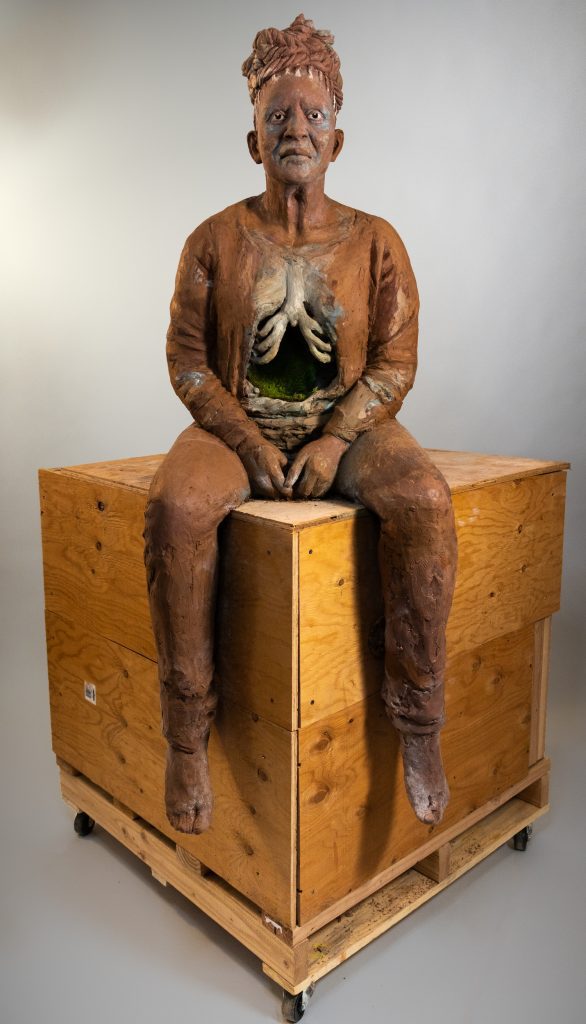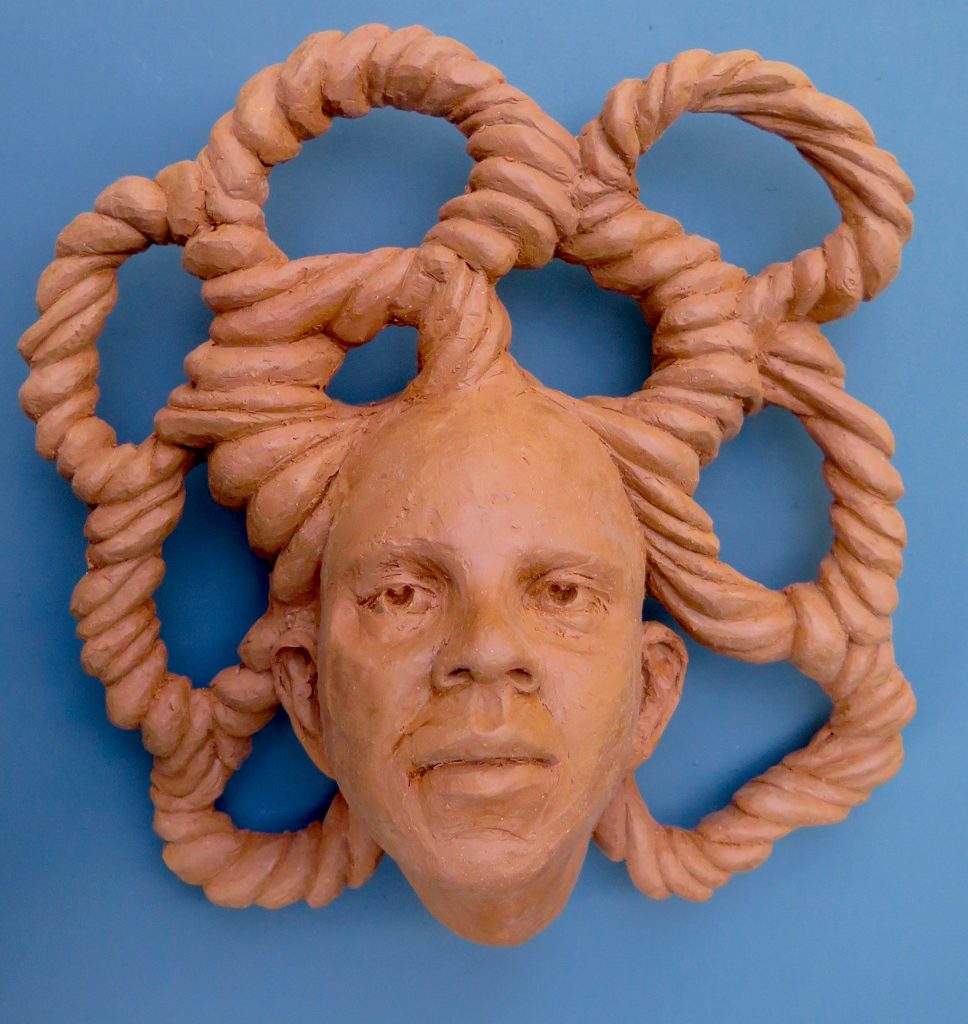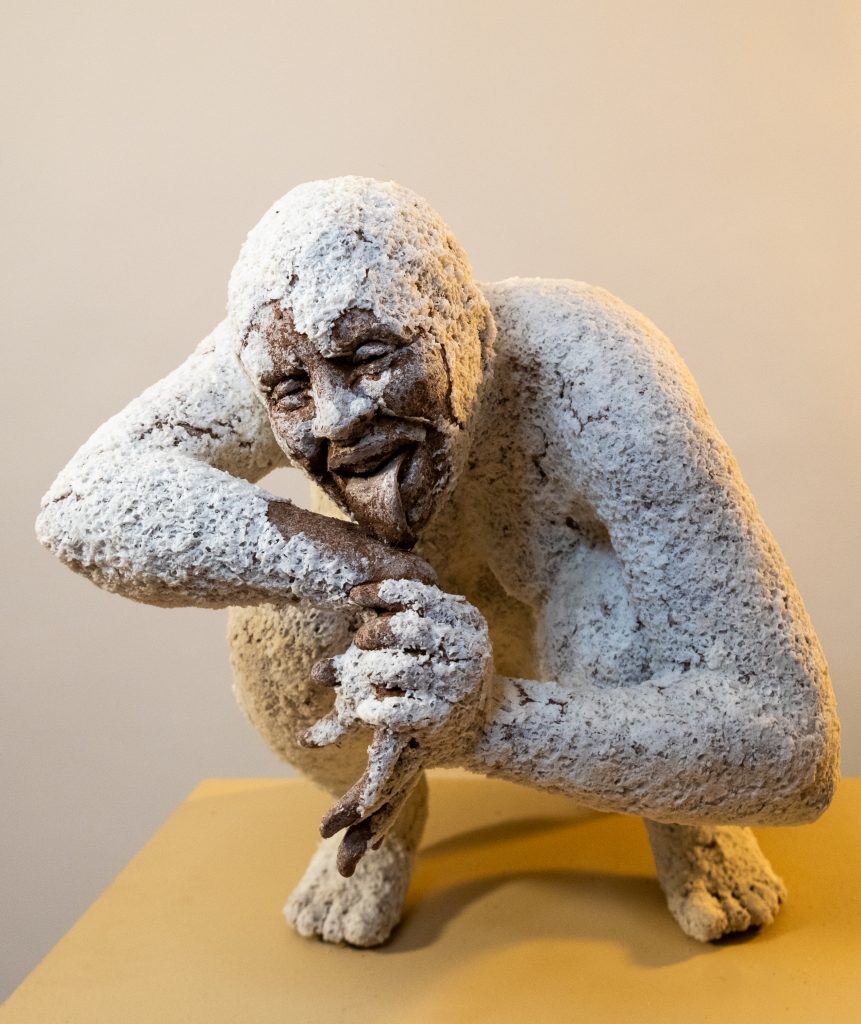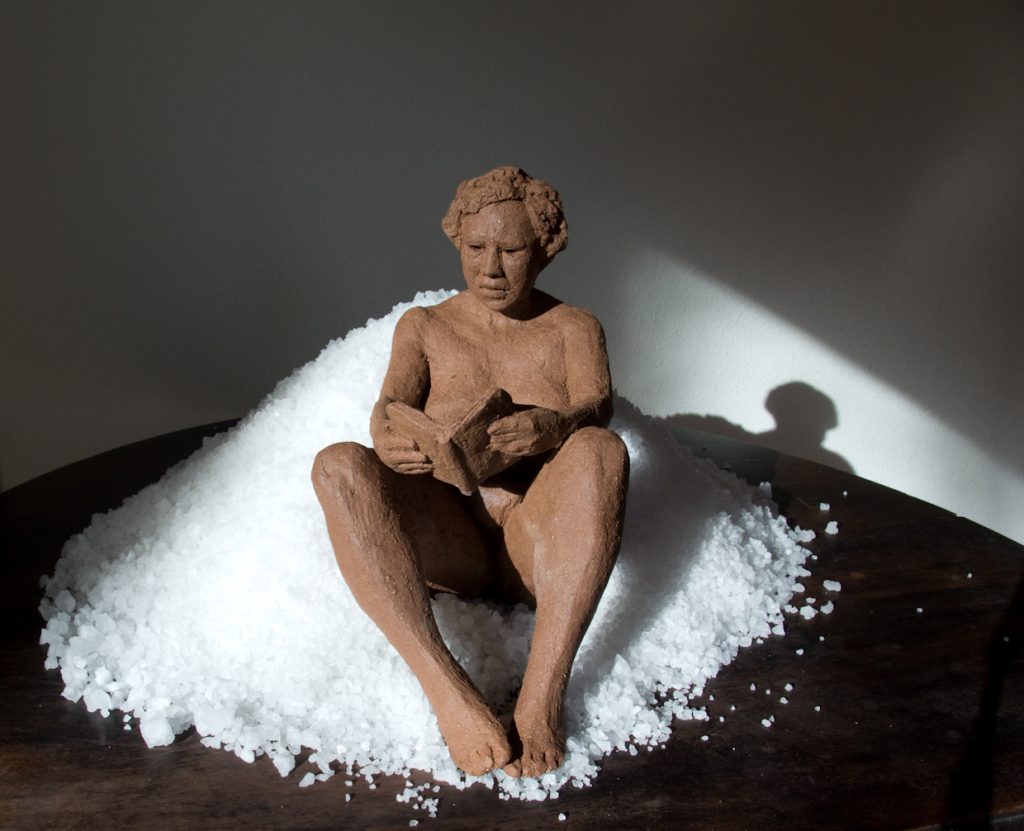By Alec Clayton
Aisha Harrison is an inventive sculptor and former art teacher at The Evergreen State College. She also does two-dimensional art, drawing and printmaking, but it is as a sculptor of strong and emphatic figures that has made an indelible mark on the South Sound art world.
“Aisha contributes so much to our community as a friend, teacher and artist,” says fellow sculptor and teacher at South Sound Community College Nicole Gugliotti. “Conversations with Aisha and time spent with her work make me feel, acutely, how art practice is a form of ritual and a way to create connection.”
In many of Harrison’s works she combines white salt with the clay for startling contrasts.
Harrison’s figures — Most of which are typically gender ambiguous, strong and non-white — range in size from a few inches in height to larger than life size. They are realistic in a gritty and unpolished, rough-surfaced manner, and are usually not glazed but left the natural reddish-brown color of the clay. She is beginning to cast some of her works in bronze and they will be available for purchase both in clay and bronze.
“I use the body and sculpture as a site for exploration of the lived experiences of racism, ancestral (human and non-human) learning and connection, and the blend of histories held within my body,” Harrison says.
“My work shows reverence for real bodies (often my own) while incorporating elements that are physical manifestations of the intangible. Almost all of my work has some sort of element that is not part of a realistic rendering,” she says. “Those elements attempt to approximate intangible things like emotions, connections, and other realities that are not physical.”
Harrison frequently gives her figures large and elaborate hair as in the small head, “Circular Memory” and the life-size “Woman With Graves at her Back.” “Circular Memory” is a face surrounded by rope-like circles of hair. “Woman With Graves…” sits on a large wooden crate staring ahead painfully, piles of hair on top of her head. Her torso is an open cave within which we see part of her ribcage.

“I’ve always thought of hair as a connection to my human ancestors through DNA. I also often use hair as a dynamic sculptural actor in my work. This hair (‘Circular Memory’) extends out in circular patterns connecting and reconnecting to itself and the head.”
In “Ancestor I,” a piece from 2018, a forest grows out of the head of a woman, her hair growing into a forest of evergreens, with red threads representing roots,veins, blood vessels connecting her heart to the roots of the trees. In “Through II,” heavy strands of hair are braided into a heart-shaped archway that stands taller than the figure it tops, and as in “Ancestor I,” red threads represent roots,veins, blood vessels. In this instance coming out of their voice box.
“‘Ancestor I’ represents the connections to my ancestors, and not just my human ancestors but also plants and animals. The face is a compilation of my human ancestors and myself. I use photographs to base features on, often combining several people’s features into one face. I feel this gives the figures a sense of Time and I always think about how my two eyes are not both for me. One of my eyes belongs to my ancestors and the other is mine. The use of several features in one face alludes to the ways I am a direct result of the sum of my ancestors. I also use reference books that have photographs of Black people from various time frames and I search through those books for faces that resonate with me. I use elements of their faces in combination with my known ancestors, myself, and descendants in acknowledgment that many of my ancestors and descendants are unknown. My work is also very based in place. The tree that I loosely based the trees on for this piece was the western red cedar which is very common where I live and is a sacred tree that I feel strongly connected to. The red threads are connectors. I see them as roots, veins, blood, long lines that connect us through time forward and backward. The red alder that grows near flowing water like rivers, sends out these beautiful red roots that get water and nutrients from the rivers. They wiggle their way between the rocks and other bank materials and stick out into the flowing water. The medicine from those red roots for me teaches me about how to stay grounded as well as flexible and how to do those things together and also how to be resourceful and get what you need.”Artist’s statement, Aisha Harrison.
On the occasion of her solo show at Salon Refu in 2013, Harrison said, “I use materials and surfaces metaphorically. The brown bare clay refers to my own brown body. The bare clay surface is never extremely smooth or refined. Instead of mimicking skin, I want the gritty, spotted clay to refer to all the elements that come together to make us who we are.”
Salon Refu owner Susan Christian describes Harrison’s work as “clay figures so compelling that I thought I’d lost my brain.”

Contrasting with and sometimes melding into the brown clay, the salt in some of Harrison’s sculptures can be startling. Such as in “Coming Together,” the brown figure of a naked woman sitting on a pile of rock salt reading a book, and “The Deposit,” which presents two brown women on a brown couch chatting. A cartoon-like speech bubble of the one speaking is a volcanic eruption of white salt. Or “Cleanse,” a squatting figure almost completely covered in salt with only their brown face and fingertips emerging from the salt.
Harrison explains that some of the pieces with white salt over brown bodies were done to educate people of European descent about racism. Looking back, she says she realizes that she was learning about her own internalized racism. She was influenced by Basia Irland’s involving pieces encrusted in salt. Harrison says for her, the salt represents a marker of privilege and in specific whiteness. “Salt crystals have migrated from parts of the body to re-crystallize on parts of the face that were bare clay before. I feel that is a good metaphor for the ways that I have been navigating internalized oppression and racism within my body.”
Harrison studied in Spain during high school and was Spanish major as an undergraduate. She loved studying Latin American literature because of the ways in which the Indigenous people used Spanish stories and images, subverting them and intertwining them with their own stories, to ensure that Indigenous peoples, images and stories survived. She calls these “camouflaged acts of resistance” that remind her of ways she navigates being of African American and Euro-American mixed heritage.

Harrison received her MFA from the University of Nebraska-Lincoln, a BFA from Washington State University, and a BA from Grinnell College in Iowa. In Baltimore, she was a resident artist at the Women’s Studio Workshop in upstate New York and Baltimore Clayworks. She taught a workshop at Penland School of Crafts and was adjunct faculty at the Center for Continuing Education Senior Institute, Community College of Baltimore County. In Olympia, she taught at The Evergreen State College from 2011 to 2019 when she quit teaching to start working in her studio full time.
Harrison’s work has been shown in the Bainbridge Island Art Museum; the Helen Smith Gallery; Greenriver College; the University of Houston, in Houston, Texas and locally at Childhood’s End Gallery; Gallery BOOM and Salon Refu. She is also part of The Black Well Red Thread Collective that has a piece called “Starbridge to Your Door” in downtown Olympia, up until December.

